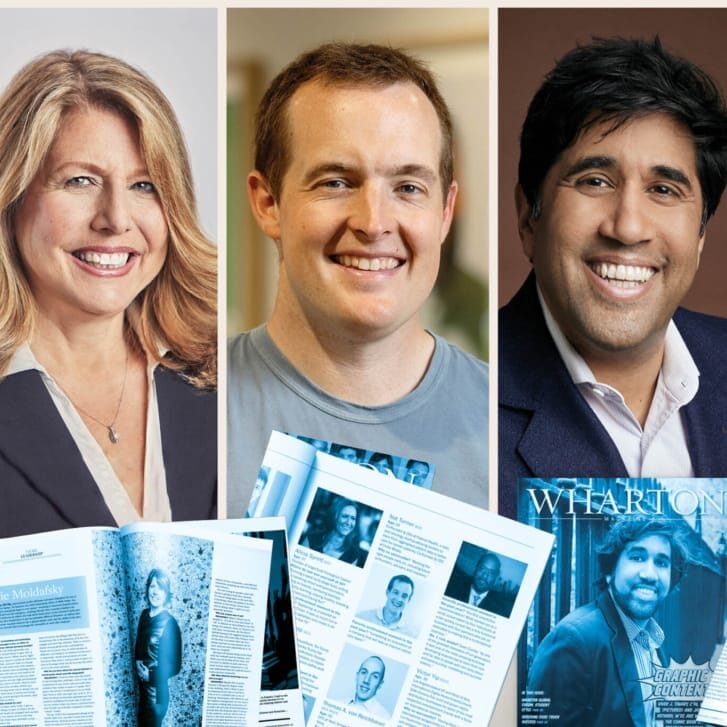America has long had a love affair with sports. We play sports, watch sports, read about sports, talk about sports, place bets on sports, and get happy, angry and disappointed over sports.
We wax nostalgic about a memorable home run, touchdown, fishing trip, tee shot, game-winning basket or swim meet. We remember how good it felt to be on the playground or city street, playing pick-up games, getting into fights over a botched play, and offering always erudite reasons why one athlete was better than another.
Above all, we knew, and still know, that sports are mostly fun. They provide challenges and opportunities for personal growth — to say nothing of physical conditioning — that few other endeavors can. Alumni interviewed for this article were more than happy to discuss why they are passionate about sports.
The Fly-Fisherman

The way of life that Ed Crutchfield, WG’65, knew as a boy is disappearing.
Crutchfield, chairman and CEO of First Union Corp., the nation’s sixth-largest bank, grew up in a town of 800 in North Carolina. His father was a country lawyer, his mother a schoolteacher. They lived on the edge of a forest 60 miles from the nearest interstate. It was a quiet place where boys learned to fish and hunt and to practice woodcraft.
Crutchfield was taught to fish at a young age by his father. But it was not until he was 20 that he found his true avocation when a friend introduced him to fly-fishing. It was on the Chatooga River, made famous in the movie Deliverance.
“The first time I saw a gin-clear stream and a fish started at the bottom of the river five feet deep and I watched him go all the way to the top and saw him attack that fly, I was hooked,” Crutchfield says.
That was in the early 1960s, Crutchfield is proud to point out, long before fly-fishing became fashionable, thanks in large part to the 1992 Robert Redford film A River Runs Through It.
“Once you flyfish,” he says, “you don’t want to do any other kind of fishing.” (A quick primer for the uninitiated: Many anglers consider fly-fishing the most challenging type of fishing because the fly-fisher does not try to catch fish, usually trout, using bait or metal lures. Instead, flyfishers use flies, which are typically made of fur and feathers delicately tied around small hooks to imitate insects that fish eat.)
Crutchfield travels several times a year to southwest Montana and New Zealand, two fly-fishing meccas, usually with old friends who have been fishing together for years.
He has fished just about all of the major rivers in Montana, including the Madison, the Yellowstone, the Beaverhead, the Big Hole and the Ruby. But his preference is for remote creeks where the anglers are few and far between.
The biggest trout ever caught by Crutchfield, who practices catch-and-release fishing, was a seven-and-a-half pound brown trout in New Zealand last year. His wife caught a six-and-a-half-pound brown on the same trip.
He also likes to hunt ducks in Arkansas and quail in South Carolina and Georgia. An avid conservationist, Crutchfield is a lifetime member of Ducks Unlimited, Quail Unlimited and Trout Unlimited. He was also involved in founding the North Carolina chapter of the Nature Conservancy and served on its board for many years. The conservancy, he says, “is the best outfit in the country” for its efforts to preserve wild places. “It’s privately funded, doesn’t rely on the government and is run by non-bureaucratic type people. Its sole mission is conservation.”
Asked to describe a memorable fishing trip, Crutchfield did not mention the biggest trout he caught. In fact, he did not mention fish at all. He said this: “Being in Montana around Labor Day when the early snow starts to fall and you’re wade fishing, say, in the Beaverhead or the Big Hole, and you realize there’s two feet of snow ahead of you. It’s probably one of the most beautiful places you can [imagine].”
Golf, Everyone?
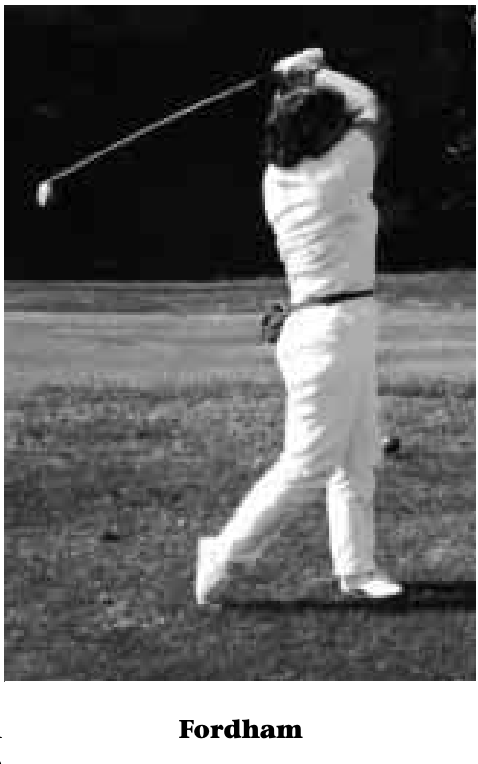
Sometimes, you can develop a passion for a sport at a moment’s notice.
In the early 1990s, Sharon A. Fordham, WG’77, traveled to a customer outing in Los Angeles from her office at Nabisco Biscuit Co. in East Hanover, N.J. She recalls looking over the list of recreational options with growing dismay: the Universal Studios tour (“which I had already done,” she says) deep-sea fishing (“a definite must-miss”), shopping on Rodeo Drive (“another must-miss”).
She opted for tennis instead and hopped on a bus that would take her to a golf-tennis complex 25 miles from her hotel. But a problem arose: the weather forecast called for a high near 100 degrees. Since Fordham is prone to migraine headaches brought on by heat, tennis became a must-miss, too. A friend suggested she join him and two others for golf instead.
“I had never even picked up a club,” remembers Fordham, who today serves as senior vice president, marketing, for the company, an operating unit of Nabisco Inc. “But I had to go play because I was going to be stuck at the complex for eight or nine hours. I went out and basically loved it. I probably missed as many [balls] as I hit. My team wound up winning the tournament and I won the ladies’ longest drive. I didn’t even know what I was doing. I won a shirt and jacket and thought golf was the greatest thing since sliced bread.”
After returning to New Jersey, Fordham signed up for lessons at a local driving range and attended a three-day golf school in Vermont. “Three months after I started playing, I hit a hole in one and I said this is definitely my game,” says Fordham.
She has discovered what golf has long offered executives — both a physical and mental challenge as well as a way to nurture friendships and business relationships outside and inside the company.
“I never appreciated the social aspects of the game,” Fordham says. “Aside from the pure enjoyment of being outside, I’ve also found it tremendously helpful in building relationships with people whom you have a hard time connecting with on other levels.”
This is especially true given Fordham’s position as a senior executive, a position that she says can leave her out of touch with employees. To remedy the situation, she began to circulate sign-up sheets that people could use to form foursomes to play on Sunday afternoons. “I got to know a lot of people I otherwise never would have gotten to know.”
Her goal is to play the major golf courses in the country. She has already played three — Winged Foot in New York, Pine Valley in New Jersey and Merion in suburban Philadelphia.
Fordham, whose handicap is “in the neighborhood” of 15 to 18, plays every weekend in the summer and is continually working to improve her game. “Unless you’re a scratch golfer, you just have a burning desire to get better.”
Ironman
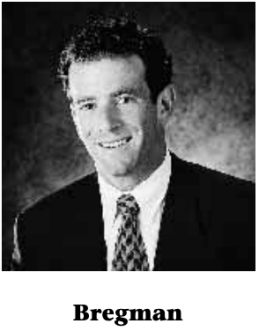
If you jog through the park in the morning, ride your bike on weekends, or occasionally swim at the local pool, you are beginning to get a glimpse — a tiny glimpse — of what it means to be a triathlete. To get a better idea of how difficult this kind of athletic pursuit is, try doing all three back to back, first swimming, then biking, then running. But if you want to experience the ultimate triathlon, do all three for a combined 140 miles. Without stopping.
That’s what Michael Bregman, W’75, a serious triathlete, has done twice in his life, in the Ironman World Triathlon Championship — an event most people probably have seen only on TV. Ironman competitions are the longest and most strenuous races that a triathlete can participate in.
Bregman entered his first Ironman in Hawaii in 1990 when he was 36, an age when Major League ballplayers and NFL nose tackles are announcing their retirements. The event began with a 2.4-mile swim in the ocean, followed by a 112-mile ride on a strip of highway through lava fields where temperatures reached 120 degrees, followed by a 26.2-mile run.
Some 1,400 people entered the race, the rules of which require participants to finish the course within 17 hours. Bregman placed about 1,100th. His time: 14 hours, 57 minutes.
“It’s a race of survival, not of time,” says Bregman, chairman and CEO of Toronto-based Second Cup Ltd., Canada’s leading specialty coffee retailer with more than 350 stores. “There’s tremendous satisfaction in crossing the finish line, so I didn’t feel like a loser. I immediately went on intravenous [to replace fluids lost during the race]. I also decided I would live some day to do it again.”
Which he did in 1995 in British Columbia. This time, he swam in a lake and raced up and down the Rockies. He finished several hours better than in Hawaii and placed in the middle of the pack.
“You have to have some form of insanity to race in the Ironman,” he says. “It’s very different than a shorter race. In the Ironman it’s very mental. The first few hours, you’re so strong. If you push too hard, you’re going to explode. At the end, you look around and realize you’re not the only one depleted of energy. It’s a very emotional experience to cross the finish line …”
Most times, Bregman takes part in less strenuous triathlons. Between the two Ironman races, for example, he competed in two to 10 triathlons of various distances each summer.
The experience does take its toll on the body. Bregman’s knees have been operated on three times and he has had his share of hamstring pulls. He raced only twice in 1998.
He also plays ice hockey and tennis and enjoys water skiing. He says that exercise, especially running, is integral to his life. “I could have the biggest problems in the world before I start running, [but] when I’m running I don’t think of anything.”
The Best of Baseball

Three years in the history of the Philadelphia Phillies are burned into the minds of die-hard fans. One is 1950, the year a youth-dominated team dubbed the Whiz Kids won the National League pennant and earned the chance to play (and lose) to the New York Yankees in the World Series. The second is 1964, when the first-place Phillies blew a 6 1/2 game lead with 12 games to play and watched their allbut-certain pennant hopes evaporate. The third is 1980, when the club, led by great players like Mike Schmidt, Pete Rose and Steve Carlton, won the series.
David Montgomery, WG’76, president and CEO of the Phillies, was only a child in 1950, but he has dim memories of how his family got its first TV and used it to watch the series. In 1964, while a student at Penn, he found himself at Connie Mack Stadium on Sept. 21 for a game against the Cincinnati Reds that turned out to mark the start of the Phils’ infamous 10-game skid and subsequent collapse.
And, in 1980, Montgomery took part in the team’s World Series victory parade. “I’ll never forget the rush of being on one of those floats,” he says.
A local boy and lifelong Phillies fan, Montgomery wanted to land a job of some kind in sports after earning his MBA. Robin Roberts, an ace pitcher from the 1950s and father of a boy whom Montgomery coached, introduced Montgomery to Phillies executive Bill Giles. The pair hit it off. Today, he and Giles are general partners in the Phils, which also has four limited partners.
Montgomery’s first job with the Phillies was in sales, telephoning fans who had expressed an interest in buying season tickets. In those days, players and other people associated with the team were asked to work the phones in the off-season to generate sales. Baseball salaries were so modest that players welcomed the chance to earn extra money. The late Rich Ashburn, a popular Whiz Kid-turned-broadcaster, was one of the guys who stood to pocket commissions if Montgomery closed on sales leads that Ashburn had generated.
“Richie always kept asking where his commission check was,” Montgomery says with a laugh. “He was not very good at keeping files. He just had pieces of paper with names and numbers on them. I called one lead and got a cemetery.”
Montgomery has seen many changes in his years in baseball: the expanded role of TV, the emergence of hightech scoreboards and mascots to bring fans to the ballpark, the rise and fall in popularity of multi-purpose stadiums, the exponential increase in players’ salaries, the growth in presence of sports agents and union strife. In recent years, a canceled World Series and player arrogance have bred fan disaffection.
Still, Montgomery is optimistic. Sports, he says, “are in many ways an opportunity for release from everybody’s routine of daily life. When we do this well, as Bill [Giles] says, we bring joy to people.”
Montgomery points to 1998, when Mark McGwire and Sammy Sosa battled for the home run title, as a special year for baseball because “it caused us to look back. Our strength is our tradition … Sure, some of the settings have changed. But our game, 90 feet between the bases and 60 feet, 6 inches from the pitcher’s mound to the plate — it all still works.”
Horse Sense
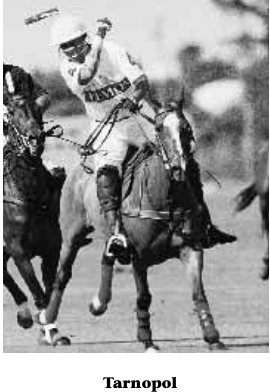
At a time when most people slow down, Mickey Tarnopol, W’58, decided to try his hand at a difficult and dangerous sport — polo. That was in 1979, when Tarnopol, vice chairman of Bear, Stearns & Co. Inc., was 42 years old.
But his love of polo had begun to blossom many years before when he was a boy working at a stable near his home on Long Island, N.Y. “I was 11 or 12,” Tarnopol recalls. “The only way to get a job was mucking out stalls.” Just as important, one of his neighbors was kind enough to take him to polo matches in Westbury, L.I. “All the great international matches were held in Westbury after World War II,” Tarnopol says. “I became a ‘hot walker,’ someone who walks horses to get them cool after they finish playing.”
But that was as close as Tarnopol would get to polo for a long while. He enrolled at Penn where he played freshman football and was a member of the university’s heavyweight crew team. After graduation, he married Lynne Lichtenstein, CW’60, launched a career in investment banking and raised two daughters, Lori and Lisa, who are also Penn alumni.
When Lisa was 15 and a top junior equestrian, Tarnopol accompanied her to a horse show at the Palm Beach Polo Club, part of the Florida horse-show circuit. He noticed a polo match taking place on the other side of the stadium.
“I said, ‘I’d love to do this,’” he remembers. Tarnopol enrolled at a week-long polo clinic in Florida. “That was the beginning of the end,” he says. “I bought a horse, another horse and another horse” and ended up with more than 40.
Throughout his career Tarnopol has played high-goal polo, which is the top tier of polo-playing and is made up of mostly pro players (the other levels are medium- and low-goal polo). “I love the competition,” he says. “It’s very rare that an adult in business has the opportunity to, number one, play a team sport, and number two, play with professionals on the same team.”
At first, Tarnopol played for a team sponsored by Rolex watches. He later formed his own team, sponsored by Revlon. Over the years, his teams won every major tournament in the United States, except for the U.S. Open Polo Championship. He has the scars to show for his efforts — broken bones, several concussions and a detached retina. “When a horse goes down on you,” he says, “that’s 1,500 pounds.”
Tarnopol retired from polo last year, playing his last home game in July at the Greenwich (Conn.) Polo Club. He led Revlon to a 12-7 victory over Cellular Farms and was named the game’s most valuable player. Most of his teammates were in their 20s. “There comes a time in every sport when everyone should retire,” says Tarnopol, 62. “I had reached a peak in my career. I didn’t want to go down from there.”
Go, New York, Go

When it came to sports, Pam Harris, WG’87, did not have a typical American childhood. Her father spent many years working for Citibank in South America and Mexico, so she had few opportunities to be a player, cheerleader, fan, or even a weekend couch potato like many of her U.S. teenage counterparts.
But each winter, the family would spend a month or so in New York and her father, a Bronx native and lifelong New York Knicks fan, would take her and her two older sisters to see the team play at Madison Square Garden.
Flash forward to adulthood in 1990: Harris holds degrees from Stanford (Denver Broncos quarterback John Elway was a member of her 1983 graduating class) and Wharton. She has worked at an advertising agency and for a consumer products company. But she notices that the National Basketball Association is growing in popularity, and she decides she wants a career change. “I was very, very, very aggressive in pursuing basketball,” she says.
She first tried to get a job with an NBA unit that was working to expand the league’s presence overseas. That job search never panned out, but the man she would have worked for had she been hired was now president of the Knicks. He called Harris and asked her to join the organization.
“I never once for a minute thought I could work for a team,” she says. “I really didn’t think regular people got jobs at basketball teams. I thought you had to be a guy, or play basketball, or your last name had to be the owner’s.”
The week after she joined in 1991, Pat Riley was named coach of the Knicks. Management began to market the team aggressively. Says Harris: “A big part of my job at the start was selling tickets because we were not selling out any games.”
She decided to revamp the whole “experience” of attending a Knicks game. Basketball was to be enhanced by entertainment. The game was to be transformed into an event. Harris developed the Knicks City Dancers to perform during games, decided that more contemporary music should be played to rouse the fans and expanded the variety of team merchandise for sale.
Basketball purists were not thrilled by the changes, but many people liked them. A new team theme song, “Go, New York, Go,” was recorded by rap singer Puff Daddy. Harris describes her goal this way: “Win or lose, how can we make sure people who come have a positive experience …” In her second year with the Knicks, the team began a streak of consecutive home sellouts that has continued unbroken in the strike-shortened season of 1999, she says.
Harris was promoted to senior vice president, marketing, for Madison Square Garden, in February 1998. Her duties now include marketing all of the events at the Garden.
The woman who once could not tell the difference between a point guard and a power forward is now learning about such sports as tennis, boxing and hockey. She calls sports the ultimate meritocracy. “It puts everybody on an equal footing … In a pick-up game, anybody can come to a basketball court. All they need is sneakers.”
The Race to Relax
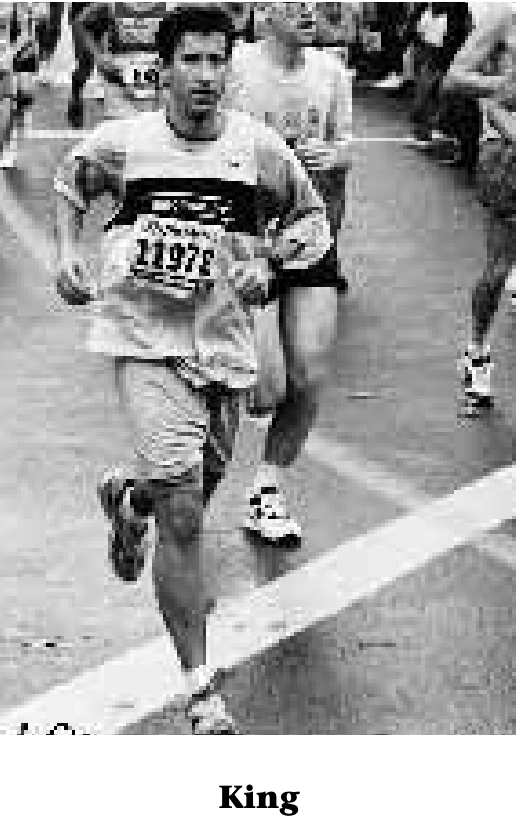
Tom King, WG’89, did not have any visions of grandeur when he became a runner. It was pretty much a practical decision.
“[Working on Wall Street] is not the healthiest lifestyle in the world,” says King, managing director at Salomon Smith Barney in New York. “You put in a lot of hours, eat three meals a day at your desk and travel a lot. To stay in shape physically and mentally, some form of daily exercise became necessary. I got more into running to keep some balance in my life.”
During each of his first six years with the company after graduating from Wharton, he entered the New York marathon. “I wouldn’t say I ran the marathon, I jogged the marathon,” he quips. “My best time was three hours, 25 minutes.”
Recently King has turned to a sport he played in high school and college — ice hockey. He and his teammates are on a club, the Outlaws, that competes regularly at Chelsea Piers near New York’s West Side Highway. “It’s nothing too intense. It’s more bankers and lawyers and people just trying to recapture their youth.” Still, the competition can get heated and fights sometimes break out, says King, whose position is left wing.
“There’s a pure physical enjoyment to hockey,” he adds. “The flip side of that is you sometimes show up at the rink a little early and there’s an A team playing and you realize how far downhill you’ve gone since your college days … I’ve always been a pretty competitive person. Hockey’s a nice outlet for that.”
Camaraderie is important, too, and King is happy that his younger brother, another Wall Streeter, also plays for the Outlaws. It’s a way for the pair to see each other on a regular basis.
In recent years King has taken up a new sport — golf. He says he has become “borderline obsessed” with the game. “I subscribe to all the golf magazines and every vacation is a golf vacation.” King’s wife, Lynn, WG’89, is also a dedicated golfer.
“In some ways golf is like running,” he says. “You’re away from work in a totally peaceful place and it can be very relaxing … My long-term athletic goal is to be a single-digit handicap golfer. I’ve got a long way to go to get there.”
Thrills on Wheels
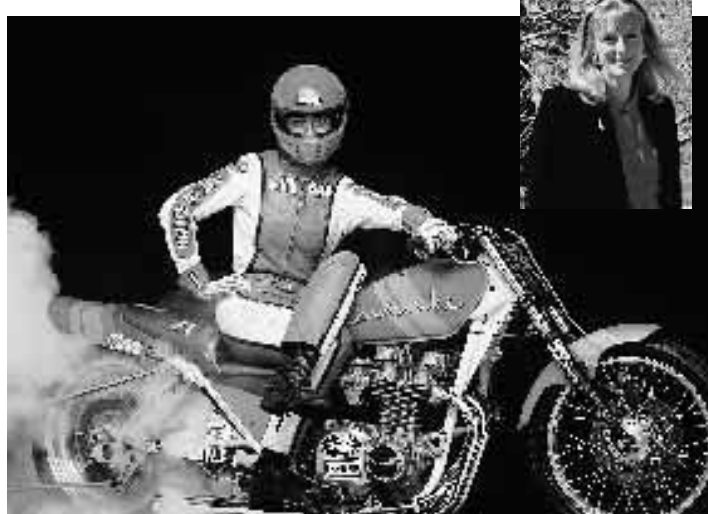
The first thing you need to know about Barbara Young, WG’95, is that she is not really into sports that much these days. Her job as program manager, internal systems, at Amazon.com Inc. in Seattle is so demanding that she has time for little else.
But from 1979 to 1987 she was into motorsports in a big way, competing full-time in motorcycle and, later, auto racing.
She raced motorcycles for three years, winning two national championships. She also set a number of speed records and was the first American to drag race on the front straightaway at the famous Le Mans speedway in France.
“I was doing well but making no money at it,” she says, “so my manager told me, ‘Get off the bike and into a car.’”
She moved from California to Charlotte, N.C., in 1984 to pursue stock-car racing. It was not an easy transition. First, she had to cope with the physical and mental challenges of learning to drive stock cars, where the races can last hours, as opposed to racing bikes on drag strips, which takes just seconds to complete.
“To go 190 miles per hour for 500 miles was a lot different,” she says. “I went from eight seconds to four hours of stress.” Plus, she had to contend with Southern car culture. “In the early 1980s, stock-car racing was a goodol’-boys sport and I was anything but — a blond woman from California,” Young says.
She attended the Buck Baker Racing School in Rockingham, N.C., and raced in a variety of not-ready-for-prime-time venues, including Caraway, a small, paved track in the Appalachian Mountains of North Carolina. “The small purses didn’t even cover the cost of new tires.”
She also competed at Tri-County Speedway in Lenore, N.C., in the “bomber” division where drivers piloted “huge land yachts that you painted with a paint brush.” In three years of stock-car racing in 57 events, Young says she won less than $5,000.
Money — or lack of it — aside, Young found racing exhilarating. She recounts one day at the track: “You fire [the car] up and it makes this great noise and you’ve got wonderful engine smells. It’s basically flat out pedalto-the-metal all the way around [the track] … It was just the sheer joy of driving and controlling that amount of power.”
After taking college courses off and on for years, Young, who was president of the Wharton Graduate Association (WGA) while an MBA student, earned a bachelor’s degree from Appalachian State University in Boone, N.C. in 1992. Today, she says working at Amazon.com is “a full-time thrill.” But she does have her sights set on a new sport — sailing. “I’m taking lessons,” she says.
A Family Affair
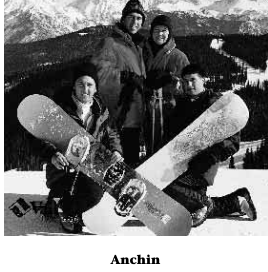
Sports, says Jim Anchin, W’65, WG’66, is a wonderful way to spend time with his wife Joan and their children, Scott, WG’96, and Lee, WG’98.
“We started skiing when our children were young. You may not ski together all the time [during the vacation], but you live together,” says Anchin, managing partner at Anchin, Block & Anchin LLP, a 76-year-old accounting and consulting firm in New York that was founded by his father and two brothers.
And as season-ticket holders and loyal fans of the New York Jets, Anchin and his family have been attending Jets games for the past 18 seasons. Tailgating is a central part of the tradition. “We play football in the parking lot before the game,” he says. “It’s a family experience.”
Sports have been important to Anchin ever since he was a boy in Mount Vernon, N.Y. He played high school basketball, took up golf as a teenager and served as the manager of Penn’s golf team. Today his handicap is 7.
“I’m a good athlete, and [golf] was a mental challenge more than a physical challenge,” he says. “I really believe you play golf against yourself. You have to learn how to control emotions. When you’re doing great, you can’t get cocky, and when you’re doing poorly, you can’t give up. Golf is truly like life.”
Because he came late to skiing, Anchin found that he likes it for entirely different reasons than he enjoys golf. “I truly enjoy the beauty of the ski slopes on a sunny day,” says Anchin, who skis mostly in Vail, Colo. “There is no pressure to shoot 79 or 80. You just want to have fun.”























